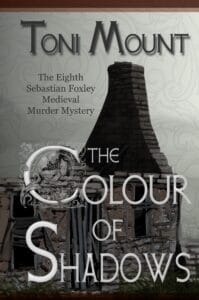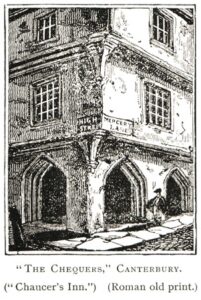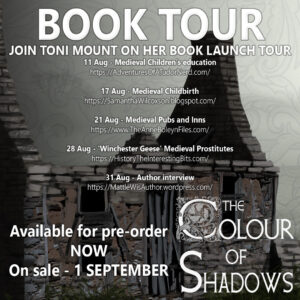 I am honoured to be hosting author and historian Toni Mount here on the Anne Boleyn Files today as part of her book tour for her latest Seb Foxley medieval murder mystery, The Colour of Shadows. I love the Seb Foxley books and have been waiting excitedly for this latest instalment. It’s available to pre-order right now and comes out on 1st September – click here to order..
I am honoured to be hosting author and historian Toni Mount here on the Anne Boleyn Files today as part of her book tour for her latest Seb Foxley medieval murder mystery, The Colour of Shadows. I love the Seb Foxley books and have been waiting excitedly for this latest instalment. It’s available to pre-order right now and comes out on 1st September – click here to order..
Over to Toni…
In my Sebastian Foxley medieval murder mysteries novels, I make good use of a map of medieval London to give the stories an authentic background. The map is entitled “The City of London in the XVth Century – Wards and Parish Churches” and I’ve had it so long, I can’t remember where it came from. Besides street names, major buildings, like St Paul’s Cathedral, the Tower of London, Guildhall and various abbeys and churches, it also names some of the inns. Now I have to be careful because not all the buildings marked as ‘inns’ were of the type that served as hostelries and pubs. The town houses of noblemen were often referred to as ‘Warwick’s Inn’, ‘Lovell’s Inn’ or ‘The Inn of the Earl of March’ and the various lawyers’ chambers, such as Grey’s and Lincoln’s Inn, began life as the residences of earls, bishops and lords. But buildings named as ‘The Saracen’s Head’ – of which there were at least two – ‘The Green Gate’ or ‘The Bull’ are likely to have been the local watering holes and/or places of accommodation for travellers.
In modern times, ‘The Railway Tavern’ and ‘The Sun Inn’ in any town are both likely to serve food and drink and may or may not have rooms for weary visitors. But in medieval times, ale-houses, taverns and inns were supposed to be quite different establishments although, by the fifteenth century, the distinctions were already beginning to blur.
I haven’t found any alehouses named as such on old maps. This is probably because they were originally what we might call ‘pop-up’ places of refreshment. Medieval ale – as opposed to beer which contains hops that act as a preservative – has to be brewed fresh at least every week and more frequently in hot weather because it goes sour. A fresh brewing was indicated, traditionally, by hanging a green branch or a bunch of leaves over the door and customers would drop by. When the ale was gone, the greenery would be removed until the next brewing was ready for drinking. So, alehouses came and went. They were only supposed to sell ale, not food nor wine.
However, alehouses can sometimes be detected by their names. ‘The Castle on the Hoop’, ‘The Sun on the Hoop’ – both just north of London Bridge – and ‘The Swan on the Hoop’ at Holbourne were all alehouses, the latter being permanent enough to appear on my map. The designation ‘on the Hoop’ seems to originate because the metal hoops that hold the staves of ale barrels in place were sometimes used to surround the alehouse sign, perhaps as an alternative to the green leaves, if these weren’t available in winter.
Taverns also sold ale but originally had the monopoly on selling wine for consumption on the premises. They weren’t supposed to sell hot food but bread and cheese were available. Food of some kind was needed, if the customers were to remain at all sober while drinking their ale and wine. Inns were larger establishments, providing accommodation for guests – sometimes as many as fifty – with stabling for their horses. Guests could have hot food and ale but, theoretically, not wine since that was the prerogative of taverns. But guests could be high-ranking nobles and prelates and would expect wine to be served.
One of the most famous London inns was ‘The Tabard’ in Southwark, recorded in Geoffrey Chaucer’s “Canterbury Tales” as the gathering place for those setting out on pilgrimage to St Thomas Becket’s tomb in Canterbury Cathedral. ‘The Tabard’ was real enough, as was ‘The Chequers’ inn [aka ‘The Chequers of Hope’] at the other end of the pilgrims’ journey through Kent, in Canterbury, on the corner of High Street and Mercery Lane. The old print below of ‘The Chequers’ gives some idea of the substantial buildings that served as medieval inns.
Like inns, some taverns also had rooms to rent and those who stayed there would want a hot meal so, by the fifteenth century, the only real difference between a tavern and an inn was likely to be the size and extent of the building.
In my Seb Foxley medieval murder mystery novels, pubs of all kinds crop up in the stories. Some really existed just as I describe them. Seb’s local, ‘The Panyer Inn’, stood in Paternoster Row, between St Michael le Querne’s Church and Panyer Alley to the east, and Ivy Lane to the west. As an inn, judging from the map, it doesn’t look to be a large building, although there could be a stable block, unnamed, off Panyer Alley. ‘The Hart’s Horn’, just outside Newgate, has been mentioned in quite a few of the novels as Mistress Fletcher’s excellent tavern and eatery. Originally, the place was my invention but I’ve since discovered ‘The Hart’s Horn’ existed as an extensive property in Southwark, belonging to the Bishop of Winchester who made it over to Merton College, Oxford, in 1479. I’ve just relocated it. Another real pub appearing in a few of my novels is ‘The Barge’ in Bucklersbury – its true location.
However, I have taken liberties with ‘The Cardinal’s Hat’. In The Colour of Shadows, this is a respectable establishment catering for upmarket clientele in Cheapside. The real ‘Cardinal’s Hat’ was a lowlife brothel in Bankside, south of the river in Southwark. In its place, as a nest of sin, I invented ‘The Mermaid’. Somehow, a clerical gentleman’s headwear didn’t seem an appropriate name for such a wicked place but, apparently, medieval folk didn’t scruple about it. Perhaps it was a joke.
‘The Pig and Pipe’ in Knightrider Street and ‘The Three Feathers Inn’ at Lambeth in The Colour of Shadows are both invented, as is Mitchet’s, a tiny alehouse guilty of serving the worst ale in London. I tend to invent the places with the poorest reputations, as I did with ‘The Pewter Pot’ in The Colour of Cold Blood [Seb Foxley no.3]. There, all sorts of heresy went on – of which I might approve – but also the mistreatment of young women, including Rose, which would never get my seal of approval. Perhaps, I don’t like to give a real alehouse, tavern or inn a bad name, even after five and a half centuries.
I hope my Seb Foxley novels give readers a true taste of medieval social life. Taverns and the like weren’t just for guzzling ale. They were places to discuss business, draw up contracts and make deals, as well as somewhere to socialise, be entertained or even find your soul-mate.
The Colour of Shadows: A Sebastian Foxley Medieval Murder Mystery (Book 8)
When Seb Foxley discovers a child’s body in his workshop and another lad goes missing, our medieval sleuth is perplexed at every turn. His investigations take him across London Bridge to Bankside in Southwark, where he becomes embroiled in the sinister shadows of the city’s underworld. Bankside is a labyrinth of depravity and crime where every harlot intends the downfall of respectable men and every scoundrel has a secret. In a netherworld unlike anything he’s experienced before, can Seb unravel the murky mysteries of The Mermaid Tavern, recover the stolen lad and restore him to his family?
Meanwhile, all is not as it should be in the Foxley household and lives are in danger as Seb’s old nemesis returns to London. More than one noble lord is mad, bad and dangerous to know. About to become a father for the second time, Seb is arrested as a murder suspect. With his apprentices behaving badly, how is our hero ever going to win the day?
The eighth Sebastian Foxley medieval murder mystery from bestselling author Toni Mount takes us deep into a dark world once again.
Click here to find out more about The Colour of Shadows and to pre-order.
Catch Toni on the rest of her book tour:


